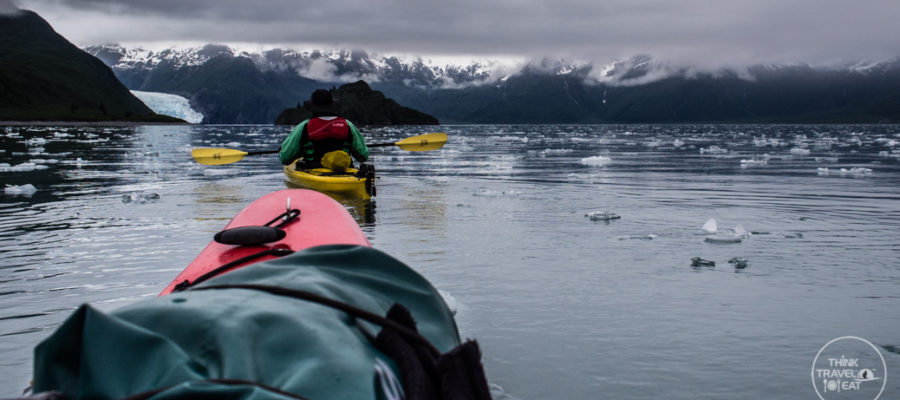Few things in the world are more beautiful than the raw, rugged nature of the vast Alaskan fjords. On the misty morning of June 1st, we set off on a sea kayaking adventure. Our destination? Aialik Glacier. Surrounded by Alaskan wilderness, Aialik Glacier flows into Aialik Bay from the Hardling Icefield.
We suited up and hauled our heavy gear through the lush wildlife sanctuary to our coastal launch site. Our gear for this adventure included paddles, kayak skirts, full body rain suits, dry bags, food supplies, 2-way radio, emergency supplies, bear spray and a knife. We loaded our kayaks as our guide offered us a quick lesson on positioning, paddling and emergency recovery techniques. Moments later, we pushed away from the beach and paddled into the icy Aialik Bay.
Into a Sea of Ice
We cautiously kayaked through a sea of icebergs of varying size and shape. While paddling through the ice, eroding icebergs rolled without warning. Because small icebergs may have large bases of ice floating under the surface, we kept our distance from their tips.
If you’re too close to an iceberg when it rolls, the base of the iceberg may capsize your vessel as it comes to the surface. You’ll face imminent hypothermic shock as you plunge into the freezing sea water. What’s more, these icebergs are much heavier than they look.

Don’t expect them to move much as you paddle your way through! For your risk, however, you are rewarded with a gorgeous ice sculpture display crafted by Mother Nature herself.
Our Favorite Cereal
Pausing to take in the scenic view of this natural ice gallery, we heard the unmistakable sound of Rice Krispies in milk. Yes, that’s right. We heard the song of America’s favorite cereal. Our guide explained that each of these bergy bits contains compressed bubbles of air that have been trapped for over 10,000 years.

As the icebergs melt into the milky green water, they release ancient air bubbles offering a sound that closely resembles a familiar snap, crackle and pop. The milky green appearance of the water itself results from the fine particles of rock, or glacial flour, created by erosion of the Aialik Glacier.
Slate Island Stretch
We paddled to our first rest point on a small rocky cove of Slate Island. Only accessible during low tide, this craggy nook offered a welcome opportunity to stretch our legs. We slid up on to the beach, stabilized our kayaks and stepped out onto the shore. Intricate, yet stable rock formations surrounding the cove provided an unexpected opportunity for scrambling. We briefly climbed among the rock formations before folding back into our kayaks and paddling back out to sea.

Abundant Alaskan Wildlife
On our way to the Aialik Glacier, we saw our first harbor seal and her pup basking on a large iceberg. Harbor seals are abundant in Aialik Bay. Pupping typically begins in May and ends in late June. According to the National Park Service, Aialik Glacier offers the most consistent opportunity for viewing harbor seals as they often use these icebergs for haul out, pupping and fishing. Another swimming seal maintained a watchful eye on us from a ranging distance of 20 to 40 feet. Curious creatures, indeed!
Behold, the Aialik Glacier!
With a thunderous crash, the calving Aialik Glacier boldly announced her presence. We rounded the bend, and there she stood in all of her deep blue, icy majesty. Oh, to be sitting in a humble kayak in front of a massive, violently calving glacier such as the Aialik!

In the face of this natural wonder, all you can do is sit in awe as building-sized chunks of ice crash into the sea right before your very eyes. Absolutely incredible.
Around the Aialik Bay
Once we had our wits about us, we realized a fisherman was shrimping nearby. We paddled over just in time to see him pulling up his first shrimp pot. A successful catch, Mike introduced himself and proudly held up his shrimp in grand display for us to see. Permits are required to fish for shrimp in the Aialik Bay, where Mike is a familiar face to those frequenting the fjords.

If one were going to invest their time fishing for shrimp, I can’t fathom a more picturesque place to do so than the Aialik Bay.
Stomachs rumbling, we paddled towards Slate Beach to stop for lunch. Our sense of adventure, however, got the best of us as we began to explore sea caves along the island. We carefully kayaked into one small cave, but most proved too dangerous to enter due to the ferocity of the crashing waves.

On arrival at Slate Beach, we greeted a team of kayakers climbing aboard a water taxi. We settled in and prepared a picnic lunch along a beach of smooth, black slate stones. As we devoured our sandwiches and hot chocolate, we remained on high alert for bear.

Note: During this time, my boyfriend took an extremely unflattering photo of me voraciously eating my sandwich. We laughingly refer to this photo as “Stephanie Eats A Sandwich”. This photo is meme worthy. Some day, I will be willing to unleash this photo onto the world. But, not just yet!
Rough Seas & Reflection
While digesting our lunch, seas took a turn for the worse as whitecaps formed on the surface. After kayaking all day, our muscles wanted nothing to do with these waves. When faced with rough Arctic seas, however, your personal feelings are utterly irrelevant.
You need to make progress, and you do not want to capsize your kayak. If you want to get back to shore, you dig in. And dig in, we did! We made it back in record time, burning though every calorie that we had consumed just a half hour before.
For me, this sea kayaking adventure was a defining moment. With the thundering roar of the Aialik glacier calving right before my eyes, I understood the awesome power of our planet. It is so easy to be swept up by the daily grind. When staring into the face of Mother Earth, however, you realize just how little everything else matters. We are lucky to be here at all–even if just for a little while.
If you want to take on this sea kayaking adventure yourself, please visit Kenai Fjords Glacier Lodge.


